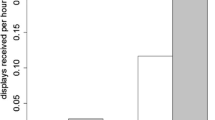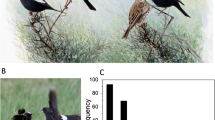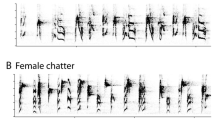Abstract
Evidence of female fomentation of male–male aggression as a mechanism of mate choice is rare, especially in mammals. Female choice of mates in polygynous species may be masked by intense male competition or by males attempting to restrict female choice. We studied protest moans of female Alaskan moose Alces alces gigas in interior Alaska, USA, from 1987 to 1990, to determine if moans incited male–male aggression. Alaskan moose exhibit a mating system in which one dominant male (the harem master) herds, defends, courts, and attempts to mate with females in his harem. Protest moans were given by females only in response to courtship. We hypothesized that if protest moans were related to females reducing harassment and exercising mate choice, females should give protest moans more frequently when courted by small males and less often when courted by large males, and that rates of male–male aggression would be elevated following protest moans. Harems were composed of one large male, with a mean of 4.4 females (median = 3 females); 10% of 132 harems included ≥10 females. The temporal pattern of protest moans from late August through November was associated with, but tended to lag behind, mating behavior. The rate of protest moans given by females decreased with increasing size of males courting them. Male–male aggression was significantly less during periods without protest moans than during periods in which protest moans occurred. These results indicate that female moose gave protest moans to reduce harassment by smaller males, and assure a mating opportunity with the most dominant male. Such a subtle mechanism of indirect mate choice by females may occur in other vertebrates in which choice is limited by a mating system in which male–male combat and male dominance over females reduces opportunities for female choice. The importance of female choice may be undervalued in studies of sexual selection in mammals.





Similar content being viewed by others
References
Altmann J (1974) Observational study of behavior: sampling methods. Behaviour 49:227–267
Andersson M, Simmons LW (2006) Sexual selection and mate choice. Trends Ecol Evol 21:296–302
Balmford A (1991) Mate choice on leks. Trends Ecol Evol 6:87–92
Berger J (1989) Female reproductive potential and its apparent evaluation by male mammals. J Mammal 70:347–358
Berger J (1992) Facilitation of reproductive synchrony by gestation adjustment in gregarious mammals: a new hypothesis. Ecology 73:323–329
Beuchner HK, Schloeth R (1965) Ceremonial mating behavior in Uganda kob (Adenota kob thomasi Neuman). Z Tierpsychol 22:209–225
Bowyer RT (1986) Antler characteristics as related to social status of male southern mule deer. Southwest Nat 31:289–298
Bowyer RT, Kitchen DW (1987) Sex and age-class differences in vocalizations of Roosevelt elk during rut. Am Midl Nat 118:225–235
Bowyer RT, Van Ballenberghe V, Rock KR (1994) Scent marking by Alaskan moose: characteristics and spatial distribution of rubbed trees. Can J Zool 72:2186–2192
Bowyer RT, Van Ballenberghe V, Kie JG (1998) Timing and synchrony of parturition in Alaskan moose: long-terms versus proximal effects of climate. J Mammal 79:1332–1344
Bowyer RT, Van Ballenberghe V, Kie JG, Maier JAK (1999) Birth-site selection in Alaskan moose: maternal strategies for coping with a risky environment. J Mammal 80:1070–1083
Bowyer RT, Stewart KM, Kie JG, Gasaway WC (2001) Fluctuating asymmetry in antlers of Alaskan moose: size matters. J Mammal 82:814–824
Bowyer RT, Stewart KM, Pierce BM, Hundertmark KJ, Gasaway WC (2002) Geographical variation in antler morphology of Alaska moose: putative effects of habitat and genetics. Alces 38:155–165
Bowyer RT, Van Ballenberghe V, Kie JG (2003) Moose (Alces alces). In: Feldhamer GA, Thompson BC, Chapman JA (eds) Wild mammals of North America: biology, management, and conservation, 2nd edn. The Johns Hopkins Univ Press, Baltimore, pp 931–964
Bowyer RT, Bleich VC, Manteca X, Whiting JC, Stewart KM (2007) Sociality, mate choice, and timing of mating in American bison (Bison bison): effects of large males. Ethology 113:1048–1060
Bro-Jørgensen J (2002) Overt female mate competition and preference for central males in a lekking antelope. Proc Natl Acad Sci U S A 99:9290–9293
Bro-Jørgensen J (2003) No peace for estrous topi cows on leks. Behav Ecol 14:521–525
Bro-Jørgensen J (2008) The impact of lekking on the spatial variation in payoffs to resource-defending topi bulls, Damaliscus lunatus. Anim Behav 75:1229–1234
Bro-Jørgensen J (2011) Intra- and intersexual conflicts and cooperation in the evolution of mating strategies: lessons learnt from ungulates. Evol Biol 38:28–41
Bro-Jørgensen J, Durant SM (2003) Mating strategies of topi bulls: getting in the centre of attention. Anim Behav 65:585–594
Byers JA, Moodie JD, Hall N (1994) Pronghorn females choose vigorous mates. Anim Behav 47:33–43
Byers JA, Wiseman PA, Jones L, Roffe TJ (2005) A large cost of female mate sampling in pronghorn. Am Nat 166:661–668
Byers JA, Byers AA, Dunn SA (2006) A dry summer diminishes mate search effort by pronghorn females: evidence for a significant cost of mate search. Ethology 112:74–80
Byers JA, Hevets E, Podos J (2010) Female mate choice based upon male motor performance. Anim Behav 79:771–778
Ciuti S, Apollonio M (2011) Do antlers honestly advertise the phenotypic quality of fallow buck (Dama dama) in a lekking population? Ethology 117:133–144
Clutton-Brock TH, McAuliffe K (2009) Female mate choice in mammals. Quart Rev Biol 84:3–27
Clutton-Brock TH, Albon SD, Gibson RM, Guinness FE (1979) The logical stag: adaptive aspects of fighting in red deer (Cervus elaphus L.). Anim Behav 27:211–225
Clutton-Brock TH, Guinness FE, Albon SD (1982) Red deer: behavior and ecology of two sexes. Univ Chicago Press, Chicago
Coltman DW, Festa-Bianchet M, Jorgenson JT, Strobeck C (2002) Age-dependent sexual selection in bighorn rams. Proc Biol Sci 269:165–172
Conover WJ, Iman RL (1981) Rank transformations as a bridge between parametric and nonparametric statistics. Am Stat 35:120–124
Cox CR, Le Boeuf B (1977) Female incitation of male competition: a mechanism in sexual selection. Am Nat 111:317–335
Darwin C (1871) The decent of man and selection in relation to sex. Murray, London
Eberhard WG, Cordero C (2003) Sexual conflict and female choice. Trends Ecol Evol 18:438–439
Garel M, Solberg EJ, Sæther B-E, Grøtan V, Tufto J, Heim M (2009) Age, size, and spatiotemporal variation in ovulation patterns of a seasonal breeder, the Norwegian moose. Am Nat 173:89–104
Hauser MD (1993) Rhesus monkey copulation calls: honest signals for female choice? Proc Biol Sci 254:93–96
Hirth DH (1977) Social behavior of white-tailed deer in relation to habitat. Wildl Monogr 53:1–55
Hunt J, Breuker CJ, Sadowski JA, Moore AJ (2009) Male–male competition, female mate choice and their interaction: determining total sexual selection. J Evol Biol 22:13–26
Jennings DJ, Gammell MP, Carlin CM, Hayden TJ (2002) Does lateral presentation of the palmate antlers during fights by fallow deer (Dama dama L.) signify dominance or submission? Ethology 108:389–401
Keech MA, Bowyer RT, Ver Hoef JM, Boertje RD, Dale BW, Stephenson TR (2000) Life-history consequences of maternal condition in Alaska moose. J Wildl Manag 64:450–462
Kokko H, Brooks R, Jennions M, Morley J (2003) The evolution of mate choice and mating biases. Proc Biol Sci 270:653–664
Leuthold W (1966) Variations in territorial behavior of Uganda kob Adenota kob thomasi (Neuman 1896). Behaviour 27:215–258
Lovari S, Bartolommei P, Meschi F, Pezzo F (2008) Going out to mate: excursion behavior of female roe deer. Ethology 114:886–898
Lovari S, Pellizzi B, Boesi R, Fusani L (2009) Mating dominance amongst Himalayan tahr: blonds do better. Behav Process 81:20–25
Maestripieri D, Leoni M, Raza SS, Hirsch EJ, Whitham JC (2005) Female copulation calls in guinea boboons: evidence for postcopulaton female choice? Int J Primatol 26:737–758
Maher CR, Byers JA (1987) Age-related changes in the reproductive effort of male bison. Behav Ecol Sociobiol 21:91–96
Mainguy J, Côté SD (2008) Age- and state-dependent reproductive effort in male mountain goats, Oreanmos americanus. Behav Ecol Sociobiol 62:935–943
Malo AF, Roldan ERS, Garde J, Soler AJ, Gomendio M (2005) Antlers honestly advertise sperm production and quality. Proc Biol Sci 272:149–157
Massei G, Bowyer RT (1999) Scent marking in fallow deer: effects of lekking behavior on rubbing and wallowing. J Mammal 80:633–638
McCullough DR (1969) The tule elk: its history, behavior, and ecology. Univ Calif Publ Zool 88:1–209
McElligott AG, Hayden TJ (2000) Lifetime mating success, sexual selection and life history of fallow bucks (Dama dama). Behav Ecol Sociobiol 48:203–210
McElligott AG, Gammell MP, Harty HC, Paini DR, Murphy DT, Walsh JT, Hayden TJ (2001) Sexual size dimorphism in fallow deer (Dama dama): do larger, heavier males gain greater mating success? Behav Ecol Sociobiol 49:266–272
McElligott AG, Birrer M, Vannoni E (2006) Retraction of the mobile descended larynx during groaning enables fallow bucks (Dama dama) to lower their formant frequencies. J Zool 270:340–345
Miquelle DG (1990) Why don't bull moose eat during the rut? Behav Ecol Sociobiol 27:145–151
Miquelle DG, Peek JM, Van Ballenberghe V (1992) Sexual segregation in Alaskan moose. Wildl Monogr 122:1–57
Molvar EM, Bowyer RT (1994) Costs and benefits of group living in a recently social ungulate: the Alaskan moose. J Mammal 75:621–630
Monteith KL, Schmitz LE, Jenks JA, Delger JA, Bowyer RT (2009) Growth of male white-tailed deer: consequences of maternal effects. J Mammal 90:651–660
Montgomerie R, Thornhill R (1989) Fertility advertisement in birds: a means of inciting male-male competition? Ethology 81:209–220
Moore AJ, Moore PJ (1999) Balancing sexual selection through opposing mate choice and male competition. Proc Biol Sci 266:711–716
Mysterud A, Langvatin R, Stenseth NC (2005) Aging and reproductive effort in male moose under variable levels of intrasexual competition. J Anim Ecol 74:742–745
Mysterud A, Bonenfant C, Loe LE, Langvatn R, Yoccoz NG, Stenseth NC (2008) The timing of male reproductive effort relative to female ovulation in a capital breeder. J Anim Ecol 77:469–477
Parker GA (2006) Sexual conflict over mating and fertilization: an overview. Phil Trans Biol Sci 361:235–259
Peek JM, LeResche RE, Stevens DR (1974) Dynamics of moose aggregations in Alaska, Minnesota, and Montana. J Mammal 55:126–137
Peek JM, Van Ballenberghe V, Miquelle DG (1986) Intensity of interactions between rutting bull moose in central Alaska. J Mammal 67:423–426
Pemberton JM, Albon SD, Guinness FE, Clutton-Brock TH, Dover GA (1992) Behavioral estimates of male mating success tested by DNA fingerprinting in a polygynous mammal. Behav Ecol 3:66–75
Pérez-Gonzáles J, Carranza J, Polo V (2010) Measuring female aggregation in ungulate mating-system research: a red deer case study. Wildl Res 37:301–310
Pizzari T (2001) Indirect partner choice thorough manipulation of male behaviour by female fowl Gallus gallus domesticus. Proc Biol Sci 268:181–186
Preston BT, Stevenson IR, Pemberton JM, Wilson K (2001) Dominant rams lose out by sperm depletion. A waning success in siring counters a ram's high score in competition for ewes. Nature 409:681–682
Rachlow JL, Bowyer RT (1991) Interannual variation in timing and synchrony of parturition in Dall's sheep. J Mammal 72:487–492
Rachlow JL, Bowyer RT (1994) Variability in maternal behavior by Dall's sheep: environmental tracking or adaptive strategy? J Mammal 75:328–337
Réale D, Bousses P, Chapois JL (1996) Female-based mortality induced by male sexual harassment in a feral sheep population. Can J Zool 74:1812–1818
Reby D, McComb K (2003) Anatomical constraints generate honesty: acoustic cues to age and weight in the roars of red deer stags. Anim Behav 65:519–530
Rowe L, Day T (2006) Detecting sexual conflict and sexually antagonistic coevolution. Phil Trans Biol Sci 361:277–285
Schmidt JI, Ver Hoef JM, Bowyer RT (2007) Antler size of Alaskan moose Alces alces gigas: effects of populating density, hunter harvest and use of guides. Wildl Biol 13:53–65
Schwartz CC, Hundertmark KJ (1993) Reproductive characteristics of Alaskan moose. J Wildl Manag 57:454–468
Schwartz CC, Regelin WL, Franzmann AW (1987) Seasonal weight dynamics of moose. Swedish Wildl Res Suppl 1:301–310
Semple S (1998) The function of Barbary macaque copulation calls. Proc Biol Sci 265:287–291
Sikes RS, Gannon WL, Animal Care and Use Committee of the American Society of Mammalogists (2011) Guidelines of the American Society of Mammalogists for the use of wild mammals in research. J Mammal 92:235–253
Stenström D, Dahlblom S, Jones Fur C, Höglund J (2000) Rutting pit distribution and the significance of fallow deer (Dama dama) scrapes during the rut. Wildl Biol 6:23–29
Stewart KM, Bowyer RT, Kie JG, Gasaway WC (2000) Antler size relative to body mass in moose: tradeoffs associated with reproduction. Alces 36:77–83
Sullivan-Beckers L, Cocroft RB (2010) The importance of female choice, male-male competition, and signal transmission as causes of selection on male mating signals. Evolution 64:3158–3171
Van Ballenberghe V (1983) Growth and development of moose antlers in Alaska. In: Brown RD (ed) Antler development in Cervidae. Caesar Kleberg Widl Res Inst, Kingsville, pp 37–48
Van Ballenberghe V, Miquelle DG (1993) Mating in moose: timing, behavior and male access patterns. Can J Zool 71:1687–1690
Van Ballenberghe V, Miquelle DG (1996) Rutting behavior of moose in central Alaska. Alces 32:109–130
Vannoni E, McElligott AG (2007) Individual acoustic variation in fallow deer (Dama dama) common and harsh groans; a source-filter theory perspective. Ethology 113:223–234
Vannoni E, McElligott AG (2009) Fallow bucks get hoarse: vocal fatigue as a possible signal to conspecifics. Anim Behav 78:3–10
Weckerly FW (1998) Sexual size dimorphism: influence of mass and mating systems in the most dimorphic mammals. J Mammal 79:33–52
Whittle CL, Bowyer RT, Clausen TP, Duffy LK (2000) Putative pheromones in urine of rutting male moose (Alces alces): evolution of honest advertisement? J Chem Ecol 26:2747–2762
Wiley RH, Poston J (1996) Indirect mate choice, competition for mates, and coevolution of the sexes. Evolution 50:1371–1381
Wong BBM, Candolin U (2005) How is female mate choice affected by male competition? Biol Rev 80:559–571
Wyman MT, Mooring MS, McCowan B, Penedo MCT, Hart LA (2008) Amplitude of bison bellows reflects male quality, physical condition and motivation. Anim Behav 76:1625–1639
Zar JH (1999) Biostatistical analysis. Prentice-Hall, Englewood Cliffs
Acknowledgments
We are grateful to M. Petrula for his assistance in the field, and to C. Whittle for helping with data analysis. This research was funded, in part, by the Institute of Arctic Biology at the University of Alaska Fairbanks, the Department of Biological Sciences at Idaho State University, the Department of Fish and Wildlife Resources at the University of Idaho, the Department of Natural Resources and Environmental Sciences at the University of Nevada Reno, and the Pacific Northwest Research Station of the US Forest Service. We thank S. Ciuti, S. A. Dunn, K. J. Hundertmark, and J. C. Whiting for their helpful comments on our manuscript. S Lovari and an anonymous referee also greatly improved our manuscript.
Author information
Authors and Affiliations
Corresponding author
Additional information
Communicated by M. Festa-Bianchet
Rights and permissions
About this article
Cite this article
Bowyer, R.T., Rachlow, J.L., Stewart, K.M. et al. Vocalizations by Alaskan moose: female incitation of male aggression. Behav Ecol Sociobiol 65, 2251–2260 (2011). https://doi.org/10.1007/s00265-011-1234-y
Received:
Revised:
Accepted:
Published:
Issue Date:
DOI: https://doi.org/10.1007/s00265-011-1234-y




